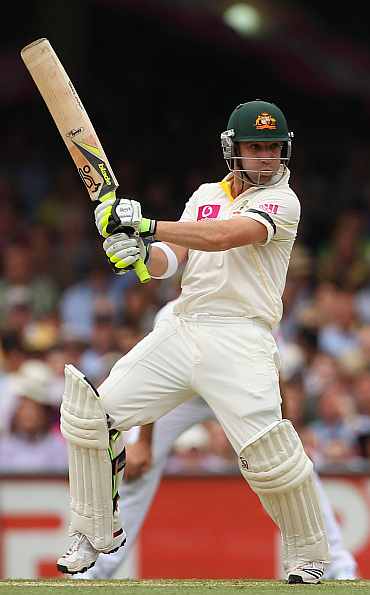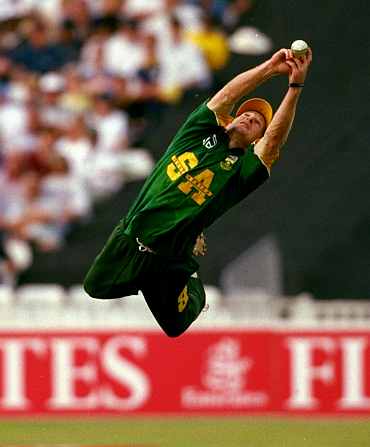 | « Back to article | Print this article |
When both openers were out on identical score
If you have a question relating to cricket and did not know who to ask, bounce them off to Rajneesh Gupta. Each week he will pick questions readers send him and provide answers. Your queries should be addressed to: Ask Rajneesh on Facebook or askrajneesh@rediffmail.com
Rajneesh's answers some questions he received from readers last week:
In the second Test between Australia and Sri Lanka, at Pallekele, both openers -- Shane Watson and Phil Hughes -- scored the same amount of runs (36) and got out, which is quite interesting. I want to know how many times openers got out after scoring the same amount of runs in Test cricket? - Mukesh Sharma
The opening pair of Shane Watson and Phil Hughes provided the 131st instance of both openers getting dismissed for same score, in the same Test innings. In addition, there have been 19 more occasions when both openers had the same score, but, either or both, remained unbeaten.
The 131 instances include 43 of both openers getting dismissed without scoring in an innings. On 50 occasions, both openers made an identical score in single digits. On 28 occasions, both openers made identical scores between 10 and 25, on seven occasions between 26 and 49; and on three occasions more than 50.
The highest identical score is 62 by Bill Lawry and Keith Stackpole, for Australia against West Indies at Adelaide in 1968-69.
When fielding won the man of the match award
Normally, the man of the match award is given for best bowling or batting. Do you have data of man of the match being given for fielding? - Amit Chitale
Gus Logie was perhaps the first player to win the award solely for his fielding. Playing against Pakistan in a Champions Trophy match at Sharjah in November 1986, Logie won the award for an exceptional display of fielding, holding three catches and effecting two run-outs.
In October 1989, Viv Richards -- playing against India in the Nehru Cup semi-final at Mumbai's Wankhede stadium -- got the award for holding three catches in the field and his captaincy.
It must, however, be said that Richards's choice as man of the match (by adjudicator Asif Iqbal) was a bizarre one, as there were several better individual performances for the West Indies than that of Richards.
South Africa's Jonty Rhodes got the award for his fielding in a Hero Cup match against the West Indies in 1993-94, when he held a world record five catches. Rhodes had also contributed 40 runs with the bat earlier in the match, but Daryl Cullinan would have beaten him on that account by scoring 70 before retiring ill.
In December 1992, Australia's Mark Taylor, playing against the West Indies, at Sydney, got the award for exceptional fielding (he held four catches) and leadership, as Australia won by 14 runs in a truncated match.
On a related note, Sri Lanka's Guy de Alwis got the award for his wicketkeeping skills -- where he held five catches -- against Australia at Colombo PSS in April 1983
Why penalise a bowler 'no-ball' because it was missed by both batsman and keeper?
As a budding scorer I have always wondered why is a bowler penalised if he delivers a no-ball that is missed by both batsman and keeper, and it goes to the boundary. In such a scenario, we show five no-balls against the bowler's name, whereas he has delivered just a no-ball.
It was the keeper's fault that he could not collect it, so why not show it as one no-ball and four byes to clearly indicate that keeper was more at the fault than the bowler.
In the above scenario, the umpire will signal a 'No-ball', followed by signals for 'Bye' and 'Boundary Four'. As scorers, we are always instructed to accept ALL signals given by the umpire. So why don't we record this signal of 'Bye'? - Anurag Sharma
Very good point, Anurag!
This is one of those cases where I don't agree with the law-makers. In fact, I have posed the same query at various platforms -- from commentators to ICC panel umpires, but have never received any convincing answer. All I have got is a tailor-made reply, "'Bye' signal is to indicate that the striker has not hit the ball".
One very famous commentator once remarked that if the bowlers are so particular about getting the penalty runs against their name, then they should not bowl no-balls! This may be true in a sense, but misses the point altogether.
I shall raise this point again with the MCC (the guardians of the Laws of Cricket) and keep all readers updated about the same.
How many India-born cricket players have represented England and West Indies Test teams? - Naresh kumar
16 India-born players have gone on to represent England in Test cricket. The complete list in chronological order is as follows (player and place where born):
KS Ranjitsinhji 'Ranji' - Sarodar
EG Wynyard Saharanpur
RA Young - Dharwar
NC Tufnell - Simla
DR Jardine - Bombay
KS Duleepsinhji - Sarodar
Nawab of Pataudi, Sr - Pataudi
ERT Holmes - Calcutta
NS Mitchell-Innes - Calcutta
GM Emmett - Agra
MC Cowdrey - Bangalore
JA Jameson Bombay
RA Woolmer Kanpur
RD Jackman - Simla
N Hussain - Madras
MM Patel - Bombay
Among the above players, three -- Jardine, Cowdrey and Hussain -- also captained the side.
Cowdrey, Jameson, Woolmer, Jackman and Hussain also represented England in ODIs. Vikram Solanki (born at Udaipur) is another India-born player to have represented England in ODIs.
Although quite a large number of players of Indian origin have represented the West Indies in Tests and ODIs, no India-born player has represented West Indies so far in either form.
What's the average runs scored per Test since 1990?
It is a known fact that sub-continental pitches are batsmen-friendly. To put it in perspective, on an average, how many runs have been scored per Test (barring washed out Tests) in the following countries since 1990. 1) Australia, 2) South Africa, 3) England, 4) India, 5) Sri Lanka, 6) West Indies. - Rohit Chauhan
Excluding all matches, where less than 100 overs were bowled, the average runs scored per Test since 1990 is as follows:
Australia - 1078
South Africa - 982
England - 1057
India - 1087
Sri Lanka - 995
West Indies - 1014
Who bowled maximum balls in a Test innings without conceding a run?
Your reply in the last column about the bowlers bowling most number of consecutive maidens made me wonder who holds the record of bowling maximum balls in a Test innings without conceding any run in that innings? - Vinayak Mane
It is Bapu Nadkarni, again, who holds the record for most number of balls bowled in an innings without conceding any runs in that innings. The leading performances in this regard are as under:
37 RG Nadkarni 6.1-6-0-1 Ind v Eng Madras 1961-62
36 JDC Goddard 6-6-0-0 WI v Eng Lord's 1950
32 S Madan Lal 4-4-0-0* Ind v NZ Auckland 1975-76
30 VS Hazare 5-5-0-0 Ind v Eng Delhi 1951-52
30 JH Wardle 5-5-0-1 Eng v NZ Auckland 1954-55
30 PR Sleep 5-5-0-0 Aus v Eng Adelaide 1986-87
* eight-ball overs
Any instance of 'left-only' attack in a Test?
Is there any instance in Test cricket where all bowlers used by a side in the match were left-arm bowlers? - Deepak Yadav
There has not been a single Test till date when a side employed 'left-only' attack in a match (excluding the Tests where very limited play was possible). There have been eight instances where a side employed only one right-arm bowler through the match. The most recent such Test was the Galle Test between Sri Lanka and Australia in September 1999. Out of the five bowlers used by Sri Lanka, four -- Chaminda Vaas, Nuwan Zoysa, Rangana Herath and Sanath Jayasuriya -- were left-armers. Only Muttiah Muralitharan was the right-arm bowler.
It may be noted that on five occasions 'left-only' attack accounted for all wickets falling in the opponent's one innings, but right-arm bowlers got to bowl in the other innings in those matches.
How many wickets have fallen in ODIs and Test matches till now? Which country tops the list for giving and taking highest wickets in both these formats? - Purnendra Verma
45,193 wickets have fallen so far in 3,194 ODIs (till Zimbabwe-Pakistan third ODI). Pakistan have lost maximum wickets -- 5,318 in 752 matches, whereas Australia have taken maximum wickets -- 5,998 in 773 matches in this format.
The total number of wickets to fall in Test cricket is 61,433 in 2007 Tests (till Sri Lanka-Australia second Test). England have lost maximum wickets -- 13,724. They have also taken maximum wickets -- 14,398.




